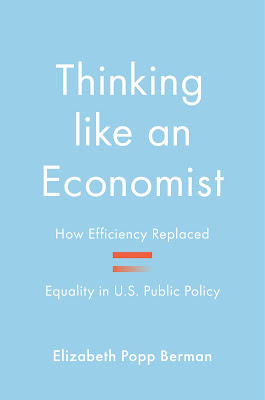Kunal Parker recently reviewed Elizabeth Popp Berman, Thinking Like an Economist: How Efficiency Replaced Equality in U.S. Public Policy (Princeton UP, 2022). There's a lot here that's relevant to the history of environmental regulation. First, Parker's summary of Popp Berman's argument, with obvious implications for understanding historically some mainstays of environmental policy, such as cost-benefit-analysis and market tools for regulation:
The book explores the rise to prominence of an economic “style of reasoning” in U.S. policymaking in the post-World War II decades. Between 1950 and 1980, Popp Berman shows, this style pervaded realm after realm of policymaking, from social welfare programs to the regulation of markets to the management of the environment.
The chief institutionalizers of the economic style of reasoning were not neoliberals or libertarians (these would become truly prominent in government only after the election of Ronald Reagan in 1980). Instead, they were Democrat-appointed economists and the bureaucrats they worked with and influenced. Albeit not ideologically opposed either to social programs or to market intervention, these economists and bureaucrats insisted that social goals be met as efficiently as possible and that market solutions were generally preferable to interventionist ones. Wherever possible, they pushed cost-benefit analyses and reviews within administrative agencies, urged the dismantling of early-twentieth-century market controls, and sought to achieve ends by creating markets for entitlements rather than by imposing standards by fiat. In all this, they shared much with those further to their right.
By the time Ronald Reagan was elected president, the economic style introduced during the Kennedy and Johnson years had become thoroughly entrenched. Indeed, it had become the hegemonic approach to solving all manner of public problems, its ubiquity and self-evidence continually reinforcing each other. Reagan Republicans would employ the economic style, but the ground had been laid for them decades earlier by Democrats. Indeed, Popp Berman argues, Democrats proved far less strategic in using the economic style than Reaganites. Democrats privileged it as a method in context after context and allowed it to subsume their substantive ends. By contrast, Reaganites were more selective and often successfully subordinated it to their substantive ends.
Parker, though, queries whether equality was actually the guiding principle in the pre-efficiency era:
If efficiency might not have been a key motivation, it is hardly clear that equality was. Stability, the orienting principle behind the regulation of financial markets since the New Deal, is not equality (and might even have entrenched inequality). The same might be said of regulation in sectors like energy and transportation.
Within administrative agencies as well, it is not clear that equality-oriented decision making was the norm before the economists assumed control. Of the culture of the Antitrust Division of the Justice Department, Popp Berman writes: “Antitrust lawyers were not generally interested in evaluating whether existing law was bad, or whether a particular merger would increase productive efficiency or reduce allocative efficiency. They were interested in winning cases: prosecuting as many violations as the law would allow in order to gain litigation experience.” (P. 85.) The same is true of lawyers at the Environmental Protection Agency (EPA), who shared a “‘culture of enforcement’ that interpreted success through the lens of winnable cases.” (P. 163.) However one might characterize this lawyerly orientation, it does not seem to be particularly oriented towards equality.
When it comes to scientists employed within agencies like the EPA, one might tell a similar story. Scientists enshrined the protection of ecosystems as a supreme value in ways that resisted logics of efficiency and equality. The first generation of environmental legislation treated environmental concerns as absolutes. Popp Berman tells us that it “built ambitious and relatively rigid rules—like simply banning water pollution unless the ‘best available technology’ for pollution control was used—because they saw inflexibility as a tool for preventing [legislative] capture.” (P. 155.)
I'm not sure I wholly agree with Parker. Reduction of pollution as an absolute value in federal legislation was to an extent meant to advance equality - state and local legislation had already made a dent in air and water pollution in the postwar period in many places, and federal regulation was in sense an attempt to extend the benefits of environmental regulation to everyone and every place in the country.

No comments:
Post a Comment